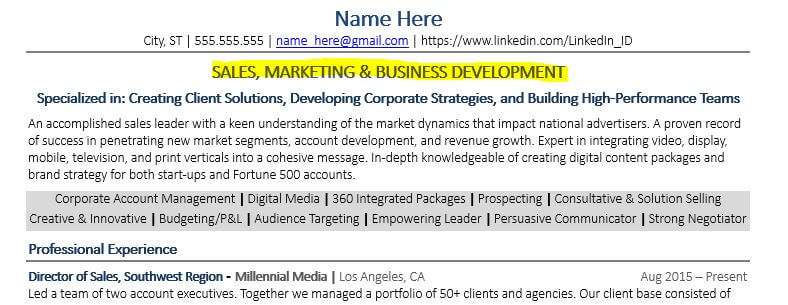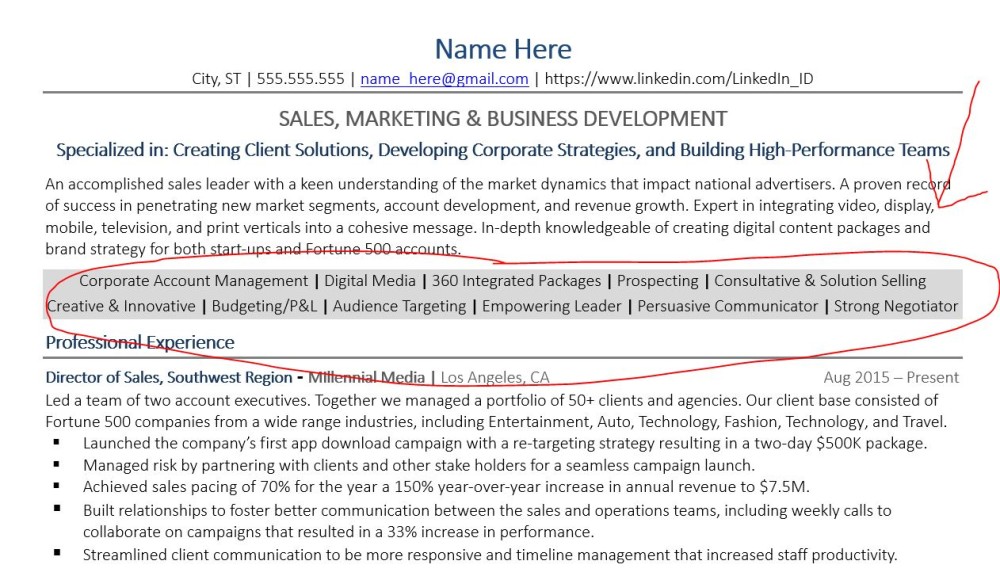Tailor Your Resume for The Job: How-To Guide

Increase your chances of landing an interview with these tips!
Hiring managers spend only seven seconds reviewing each new resume. In that short amount of time, they must determine whether you are the right fit for the vacancy.
You need to align your application with the job to boost your chance of getting past this point. Don’t worry, though. We’ve got you covered.
Learning how to tailor your resume is easier than you might imagine. Read our complete guide now.
Is tailoring your resume worth it?
First, let’s talk about why you should bother tailoring your resume. Sure, it’s easier and less time-consuming to use a one-size-fits-all approach. But if you are not getting the results you need, you might find that this is the thing holding you back.
Let’s take a look at the two main benefits of tailoring your resume to meet the needs of the employer:
Speak the hiring manager’s language
Think about things from a hiring manager’s perspective for a moment. If you’re trying to fill a project management or customer service manager position, what do you want to see? Do you want to review a generic resume that could apply to any job? Or would you prefer one that seems as though it was written with your company in mind? The answer should be obvious.
Get ahead of the competition
The truth is that you need to tailor your resume during the job search to have any real chance of positive results against other applicants. That’s the only way to ensure you are properly addressing a given company’s job requirements. This is also the best way to demonstrate to a hiring manager or employer that you’re the right candidate for the open position. Non-specific resume templates simply can’t achieve that objective.
Beat the ATS software
Applicant Tracking Systems, or ATS, is software that sifts through incoming resumes. The program looks for specific keywords that describe your skills, experience, education, and other qualifications. The more matches you get, the more likely you are to pass the test. By looking at the wording of the original job advert, you can pick out keywords to use within your resume.
There are many reasons you need to tailor your resume but it boils down to this: when your resume is a good fit for the job, you’re more likely to land yourself an interview. Taking a few minutes to ensure that your application aligns with an employer’s needs is a no-brainer.
Expert Tip
Don’t waste your time!
Creating multiple versions of your resume and saving them ahead of time is a mistake. Instead, you need to create a single, well-formatted resume that you can easily tailor to new job vacancies. Make high-impact keyword changes while keeping the basic structure of your resume. When done correctly, it should only take a few minutes.
How to use resume keywords like a pro
Before we examine the different sections of your resume, we have a secret to share. Tailoring your resume is all about leveraging choice keywords. You want to make your resume the perfect fit for a certain position. That means trimming, expanding, and adapting your resume to fit the job requirements – as a tailor does with a piece of clothing.
If you haven’t heard of keywords before now, you’re in for a real treat. Using the right phrases can make a world of difference when you are applying for jobs. Let’s kick things off by breaking down what resume keywords are and why they are so important when tailoring applications.
What are resume keywords?
Keywords give you an insight into what the hiring manager is looking for. These are specific to each job description. For example, if a job description lists experience with ‘customer service’ as a requirement, your resume should include the exact phrase ‘customer service.’ If you want to take things to the next level, you might even include this phrase more than once – as long as it makes grammatical sense and fits within the context of what you’re saying.
Remember, the job description is describing the ideal candidate. That is exactly how you want to portray yourself. To tailor your experience and fit that description, you should use the exact phrases provided. That way, when the ATS scans your resume, it is likely to pass. Equally, when the hiring manager reads your resume, they will be impressed by your aligned skill set.
Expert Tip
Avoid using synonyms!
Some candidates make the mistake of using synonyms for keywords. You might think that you don’t want to copy the exact wording from the job advert, so you use a similar phrase. That won’t do because the ATS is looking for exact phrases. For example, if you state that you have ‘client liaison’ skills when the keyword is ‘customer service,’ you may find that your resume is rejected before the hiring manager even sees it.
How do I use keywords?
By placing the right job keywords in the right places on your resume, you can satisfy those applicant-tracking scanners and human readers. Your resume will be a great fit for each job.
This means you should be selective about what jobs you apply to. You should keep your resume accurate, so only include keywords (skills, experience, and education) that you actually have.
ZipJob’s team of career experts suggests active job seekers apply to 10 to 15 jobs per week with a highly-tailored resume. Keep in mind that it’s about quality, not quantity.
In theory, all you need to do to successfully tailor your resume is to identify relevant words from a job description and use those keywords in your resume. In practice, you need both a solid, flexible resume and an eye for picking out the important parts of a job description.
The easiest places to tailor your resume quickly are your resume title or headline, your core competencies, your professional summary, and finally, your work experience section. In the following patriot of this guide, we will talk about how you can tackle each of these sections.
How to tailor your resume title
A resume title (also known as a resume headline) is a big opportunity most job seekers miss out on. Your resume title, as opposed to your job titles, can reflect your career goals and key qualifications. It’s not an official title; it’s a headline that previews your resume in a few words.
To see the most impact here, the title of each tailored resume that you send out needs to be specific and directed toward that particular open position. Let’s take a look at an example:

You need to make sure your resume headline aligns with the advertised job. Here are some quick tips that you can use to ensure that it is hitting the mark:
Use the exact job title. If the position calls for a ‘Director of Marketing,’ don’t apply with a resume headline that says ‘Marketing Manager’. Be as specific as you can.
Back up your claims. Add some professional qualifications. For example, write ‘Director of Marketing – Master’s Degree & 7 Years Marketing Management Experience.”
Keep it short and snappy. You don’t have many words to play with. Ensure your headline is memorable while including the main keyword (i.e. the advertised job title).
You might want to spend some time drafting different headlines. This part of your resume is often the first thing that hiring managers see, so it’s worth getting right. For more examples, you can also check out our advice on crafting the perfect resume title here.
How to tailor your resume core competencies
The second best place to tailor your resume is the core competencies section. At ZipJob, we favor core competency sections over skills sections because a job seeker’s competencies often include both skills and personality traits or behaviors.
Like a resume title, your core competencies can be tweaked to better suit a given position. In fact, core competencies can be one of the most important resume areas that will get your resume noticed! Here’s how to do that:
Highlight keywords in the advert. Your resume should align with the keywords used in the specific job description. The core competencies, as a targeted list of skills and abilities, are a great place to swap out general words for keywords.
Include those words in your list. For example, if a job position requires ‘web design/development experience’, ensure that those keywords are on the resume. You can start by placing that keyword phrase in your core competencies section.
Repeat the phrase later. Highlight your practical experience by using the phrase again in your work experience section. We’ll talk more about that later on.
Here is an example of a core competencies section where you can easily tailor your keywords to the job description:

Your core competencies include your relevant knowledge base and skills. When you develop your tailored resume, you should make sure that these competencies are detailed using the job description keywords. That can help you in two important ways:
Focus your resume. Use the job description’s keywords to help you focus your resume on that company’s open position.
Beat the bots. Use keywords to help your resume get past automated Applicant Tracking Systems and into the hands of a live human.
You should use short phrases to describe the skills. That way, you give context to the core competencies that you are sharing throughout your tailored resume.
List those core competencies in your summary to ensure that recruiters and hiring managers see them. That helps to dispel any doubts about whether you’re a qualified fit for the specific job by directly answering that question as early in the resume as possible.
How to tailor your resume summary
Your resume summary is another powerful tool that can help you customize your application. Like the resume title and the core competencies section, the summary is often either overlooked or inefficient. When we talk about how to do your resume like a pro, don’t miss this section.
Let’s take a look at how you can tailor your resume summary to meet the job advert. Here are some easy yet impactful things that you can (and should) be doing:
Identify the desired qualifications. This is the key difference between a resume objective and a resume summary: the resume summary must be employer-focused. Look back at the job advert and highlight any qualifications they specify there.
Remove irrelevant words. Your summary is short — just 2-4 lines. Work to align this section with what the employer requires. That means removing anything that isn’t relevant to the position. There is simply no room to waste words here.
Add the details the employer requires. Now, include the qualifications, experiences, and other information that supports your candidacy. As previously mentioned, you can usually find these in the job advert. If you meet the criteria, shout about it.
Front-load your resume summary. Keep the most relevant information toward the beginning of your summary. You can end with impressive information that is not required, such as foreign language fluency, awards won, or bonus technical skills.
Your summary is the only free-form part of your resume. What you write here counts. Make sure you include the most important keywords (and qualifications) in this section. It may be helpful to write out a few different summaries and pick the strongest one from your list.
If you’re not sure where to start, we have you covered. Take a quick look at our example below:

How to tailor your resume employment history
This next tailoring trick is the most time-consuming task on our list, but it is effective. Tweaking your work experience section will help you get ahead of the competition.
As tempting as it might be to just leave your employment history intact for each submission, that can cause you to miss opportunities. You should edit job descriptions and achievements to improve how closely they align with the job you’re seeking.
Customize those entries so that they shine a spotlight on skills and work experience that demonstrate that you’re the right person to handle the new position. The keywords you added to other parts of your resume (at this point, that should be the resume title, core competencies, and professional summary sections) can be expanded upon here. Here’s what to do:
Check the job description. Look for any overlap in your work experience and what the employer needs. Highlight it and then check the phrasing you use in your work experience section. It may be as simple as changing the wording you have used.
Add some details. If you added Photoshop as a core competency, expand on that now. You may be so good at Photoshop because you created all the social media graphics and marketing materials for your last job. Include this information in your bullet point.
Remove redundant points. If your resume is running too long, you’re going to need to edit it. Your work experience section is a good place to start. Once you’ve added points that align with your chosen keywords, remove any redundant points from this part.
When we talk about how to tailor your resume, many people overlook this section. Frankly, that is because it can appear intimidating. You may have crafted the perfect achievements beneath each job title. However, this part is key when you’re going up against other candidates.
Think about it — if it comes down to a couple of resumes, the hiring manager is going to choose the one that best suits the job description. Setting aside some real time to tailor your work experience may sound challenging, but the payoff is great. Go ahead and do it now.
Tailored resumes win interviews
While it definitely takes some extra effort to tailor your resume for different types of positions, it is an absolute necessity if you want to get noticed these days. Generic, one-size-fits-all resumes just won’t cut it anymore. A well-tailored resume will maximize your odds of job search success. So, learn to tailor your resume to a job posting the right way; chances are that it’s just what you need to finally get that job you deserve.
Applying for jobs? Make sure that your resume hits the mark now. Get a free resume review from our team of experts today.
This article was originally written by Leo Bastone and has been updated by Charlotte Grainger.

